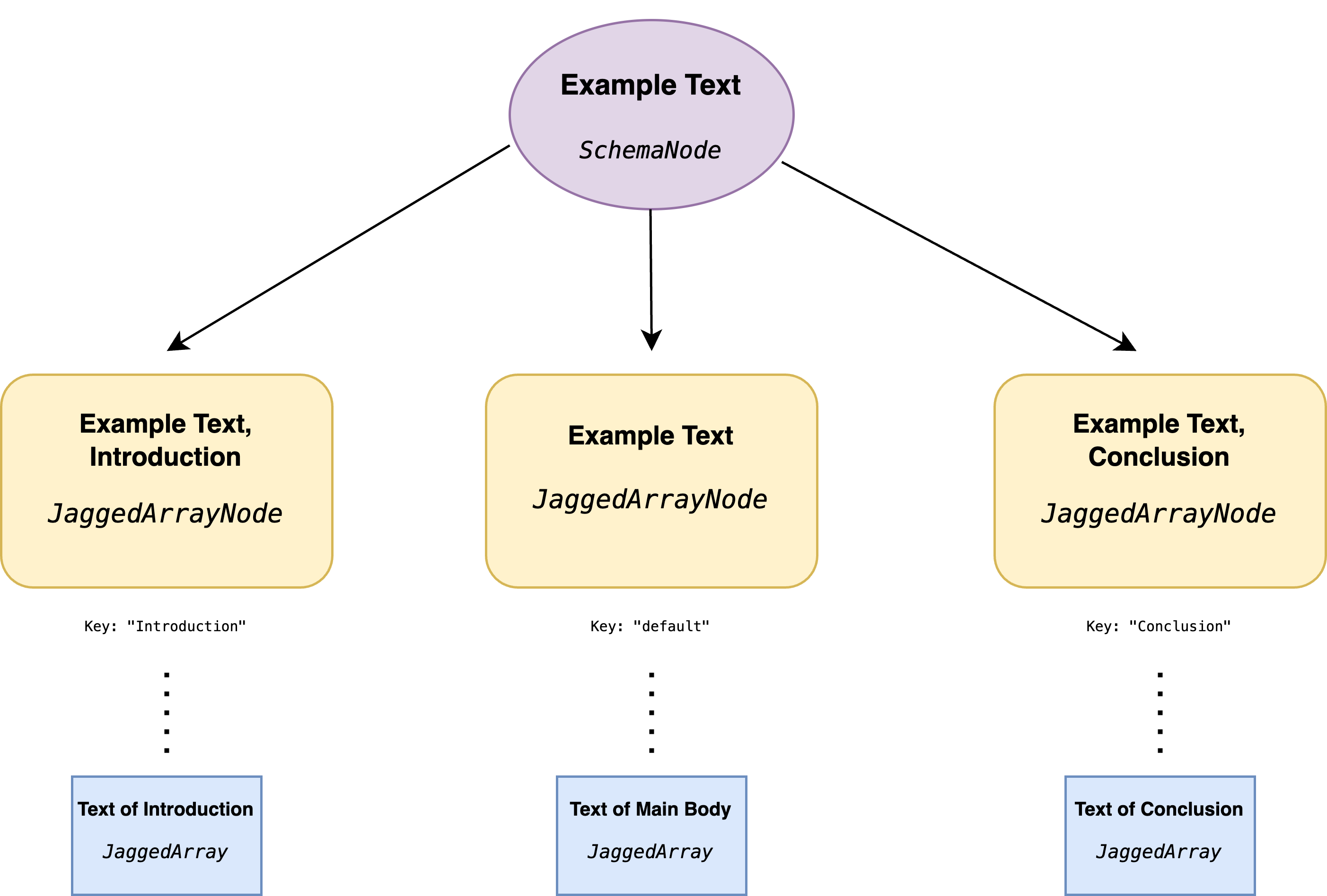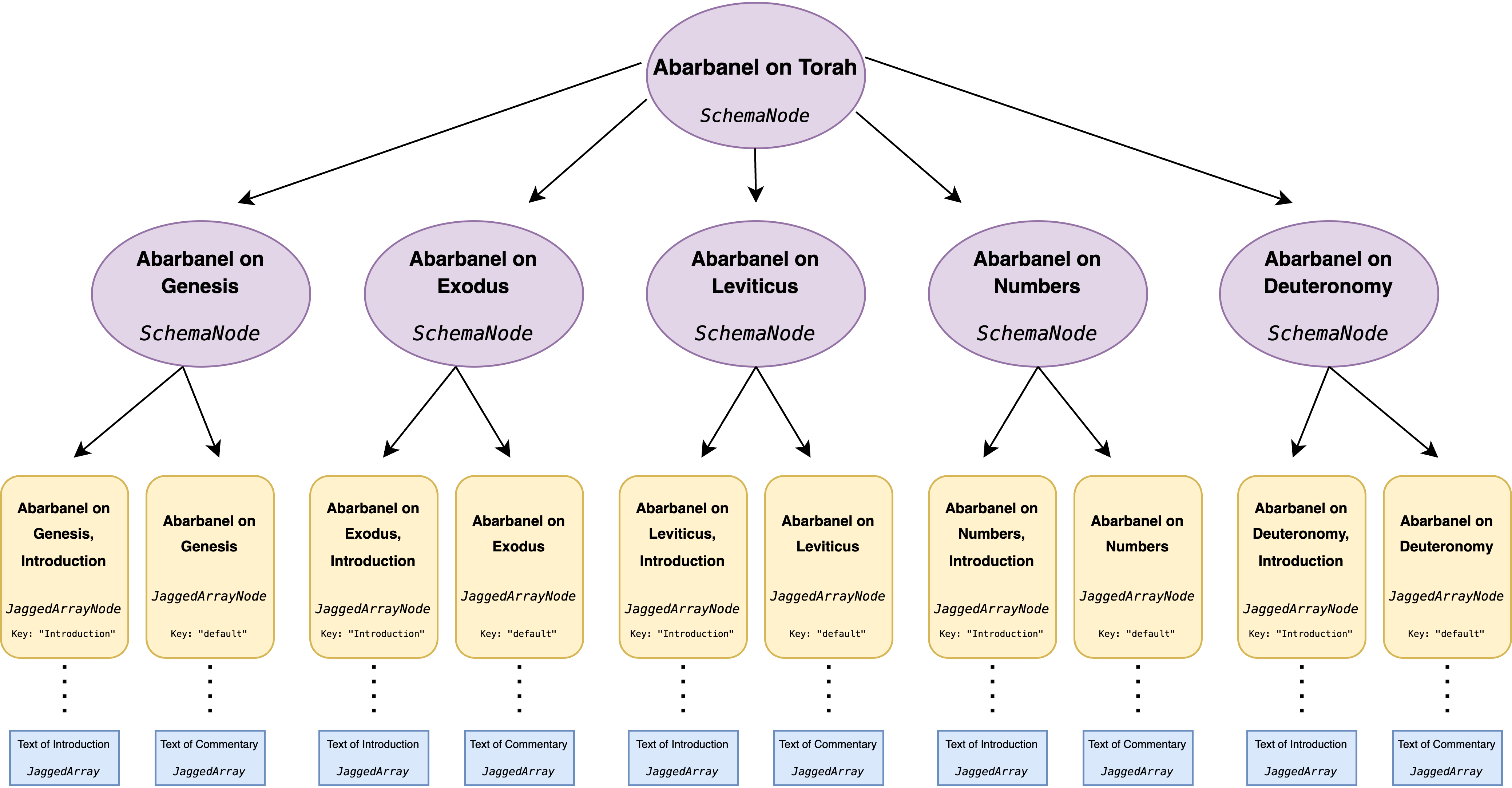The Structure of a Complex Text
Exploring the Index schema of "complex" texts and how they work in structuring texts at Sefaria
Complex Schemas (Multi-Node Trees)
Texts which are more complex than a simple Jagged Array need a complex Index schema. Complex schemas are always structured as trees made up of many nodes, usually a combination of type SchemaNode and JaggedArrayNode. Each node has a key and titles. If it is a SchemaNode, it will have other nodes as children; otherwise it is a JaggedArrayNode describing JaggedArray content.
Note: Thetitles blocks in all of the examples below were left as empty arrays for the sake of brevity, and sharedTitle were omitted for the same reasons. We will dive deeper on titles in Schema Node Titles
Example 1: A "Simple" Complex Text
Let's look at a moderately complex text, and then at the Index Schema that describes it. This text has the following three sections:
- Introduction - Structured as a series of paragraphs
- Main Body - Structured by chapters containing sections
- Conclusion - Structured as a series of paragraphs
The text looks like this when viewed in a JaggedArray:
{
"Introduction": ["Intro Paragraph 1", "Intro Paragraph 2", ...],
"Contents": [
["Chapter 1, Section 1", "Chapter 1, Section 2"],
["Chapter 2, Section 1", "Chapter 2, Section 2"],
...],
"Conclusion": ["Conclusion Paragraph 1", "Conclusion Paragraph 2", ...]
}
The schema, as serialized in the Index record, looks something like this:
"schema" : {
"nodes" : [
{
"nodeType" : "JaggedArrayNode",
"depth" : NumberInt(1),
"addressTypes" : ["Integer"],
"sectionNames" : ["Paragraph"],
"titles": [...],
"key" : "Introduction"
},
{
"nodeType" : "JaggedArrayNode",
"depth" : NumberInt(3),
"addressTypes" : ["Perek","Pasuk","Integer"],
"sectionNames" : ["Chapter","Verse","Comment"],
"default" : true,
"key" : "default"
},
{
"nodeType" : "JaggedArrayNode",
"depth" : NumberInt(1),
"addressTypes" : ["Integer"],
"sectionNames" : ["Paragraph"],
"titles": [...],
"key" : "Conclusion"
}
],
"nodeType" : "SchemaNode",
"titles" : [...],
"key" : "Example Text"
}The root node in the schema, besides the required key and titles attributes, has an attribute called nodes. nodes is a list of dictionaries, with each of those dictionaries itself containing a node. Look at the keys of each of those children. They match the keys of the dictionary of the text. Each of the child nodes in the Index record describes how that section of the text is structured.
Let's take a step back, and conceptualize the structure of this Index record as a tree:

You'll see that at the root of the tree there is a SchemaNode representing the entirety of the text. This SchemaNode has three JaggedArrayNode children, each representing the content of that section which is stored on the Version in an associated JaggedArray.
Example 2: Abarbanel on Torah
For a more complicated example of a complex text, let's look at the Abarbanel on Torah. The Abarbanel on Torah has a more nuanced structure, with multiple layers of SchemaNodenodes. The Abarbanel has a verse-by-verse commentary on each of the five books of Torah, and for each book he also writes an introduction to his commentary on that book.
The schema as it appears on the Index record can be seen in the snippet below.
The Index Record Schema for Abarbanel on Torah
"schema" : {
"nodes" : [
{
"nodes" : [
{
"nodeType" : "JaggedArrayNode",
"depth" : NumberInt(1),
"addressTypes" : ["Integer"],
"sectionNames" : ["Paragraph"],
"key" : "Introduction"
},
{
"nodeType" : "JaggedArrayNode",
"depth" : NumberInt(3),
"addressTypes" : ["Perek","Integer","Integer"],
"sectionNames" : ["Chapter","Verse","Paragraph"],
"default" : true,
"key" : "default"
}
],
"titles" : [...],
"key" : "Genesis"
},
{
"nodes" : [
{
"nodeType" : "JaggedArrayNode",
"depth" : NumberInt(1),
"addressTypes" : ["Integer"],
"sectionNames" : ["Paragraph"],
"key" : "Introduction"
},
{
"nodeType" : "JaggedArrayNode",
"depth" : NumberInt(3),
"addressTypes" : ["Perek","Integer","Integer"],
"sectionNames" : ["Chapter","Verse","Paragraph"],
"default" : true,
"key" : "default"
}
],
"titles" : [...],
"key" : "Exodus"
},
{
"nodes" : [
{
"nodeType" : "JaggedArrayNode",
"depth" : NumberInt(1),
"addressTypes" : ["Integer"],
"sectionNames" : ["Paragraph"],
"key" : "Introduction"
},
{
"nodeType" : "JaggedArrayNode",
"depth" : NumberInt(3),
"addressTypes" : [
"Perek",
"Integer",
"Integer"
],
"sectionNames" : [
"Chapter",
"Verse",
"Paragraph"
],
"default" : true,
"key" : "default"
}
],
"titles" : [...],
"key" : "Leviticus"
},
{
"nodes" : [
{
"nodeType" : "JaggedArrayNode",
"depth" : NumberInt(1),
"addressTypes" : ["Integer"],
"sectionNames" : ["Paragraph"],
"key" : "Introduction"
},
{
"nodeType" : "JaggedArrayNode",
"depth" : NumberInt(3),
"addressTypes" : ["Perek","Integer","Integer"],
"sectionNames" : ["Chapter","Verse","Paragraph"],
"default" : true,
"key" : "default"
}
],
"titles" : [...],
"key" : "Numbers"
},
{
"nodes" : [
{
"nodeType" : "JaggedArrayNode",
"depth" : NumberInt(1),
"addressTypes" : ["Integer"],
"sectionNames" : ["Paragraph"],
"key" : "Introduction"
},
{
"nodeType" : "JaggedArrayNode",
"depth" : NumberInt(3),
"addressTypes" : ["Perek","Integer","Integer"],
"sectionNames" : ["Chapter","Verse","Paragraph"],
"default" : true,
"key" : "default"
}
],
"titles" : [...],
"key" : "Deuteronomy"
}
]You'll see that the schema is a JSON object, with a nodes key that contains an array of five JSON objects, each one representing a SchemaNode pointing to the introduction and commentary corresponding to each book of Torah. Each of these JSON objects has a nodes key, which points to an array of the two JaggedArrayNodes which correspond to the JaggedArray for the introduction and the commentary for the given book.
Let's visualize this as a tree:

The Schema of Abarbanel on Torah as a Tree
You can see in the above diagram that the Abarbanel on Torah has two layers of SchemaNode nodes (represented by the purple circles). The root is the SchemaNode representing the entire Index. The immediate children are each a SchemaNode representing the Abarbanel's commentary on one of the Five Books of Torah. The children of each "book-level" SchemaNode are JaggedArrayNodenodes (represented by the yellow rectangles). Each book has a JaggedArrayNode for the Introduction (with a key of Introduction) and a JaggedArrayNode for the main body of the commentary on that book (with a key of default, more on that in Default Nodes). Each JaggedArrayNode corresponds to an actual JaggedArray (i.e. a list of lists, represented by the loosely associated blue rectangles) on the Version of the text containing the actual text of that corresponding section of the Index.
Summary
Schema trees can descend to any depth. Each Index will have different structures, varying greatly in composition and complexity. It is crucial to understand JaggedArray, JaggedArrayNode, and SchemaNode. With these building blocks, one can understand how Index schema trees are built, and how to read the schema as presented in serialized form on the Index record. This knowledge underlies every work in the Sefaria library, and is key to a deep understanding of how we store and structure text.
Updated about 2 months ago